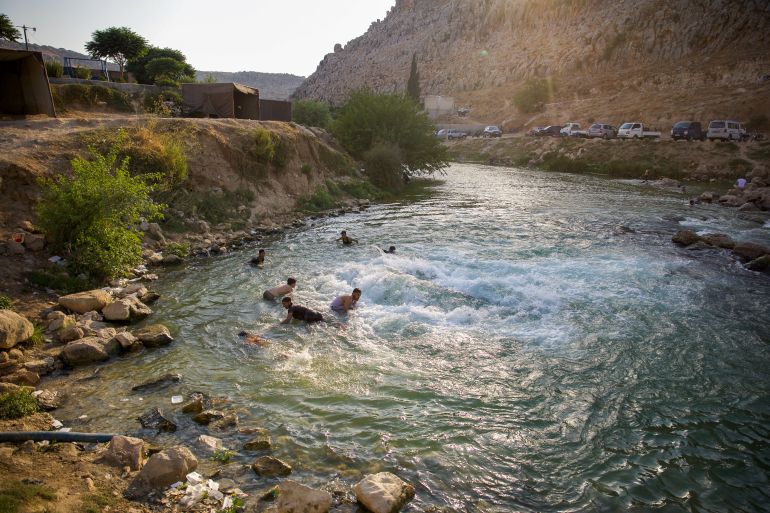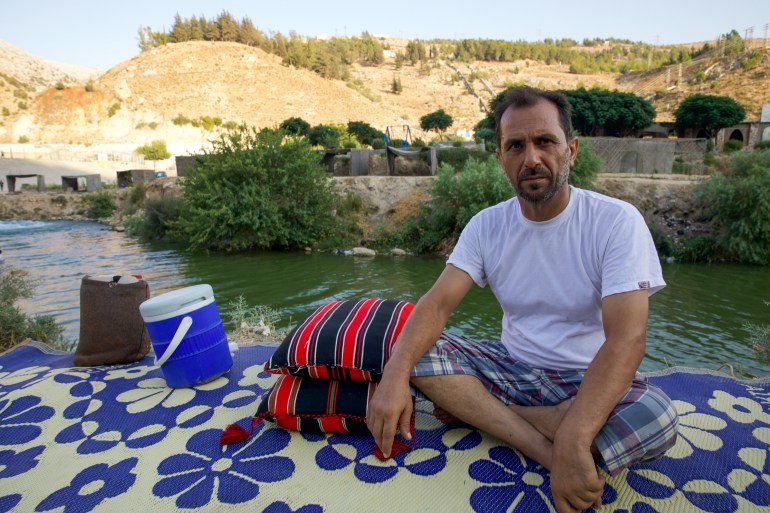To beat the heat in northwestern Syria, people head for the water
In a region decimated by an earthquake and populated mostly by IDPs, the intense heat is making life even harder.

Idlib, Syria – Northwestern Syria has not been spared from the soaring temperatures other spots around the globe are struggling with.
As people suffer in the intense heat, they are finding their daily lives and livelihoods affected by the season.
Keep reading
list of 4 itemsPhotos: Record temperatures continue to sizzle around the world
Soaring Mediterranean temperatures bring death and destruction
Extreme heat hits Iraq, as temperatures exceed 50 degrees Celsius
Anas Rahmoon, a meteorological expert in Idlib, told Al Jazeera that the highest-recorded temperatures were on August 13 and 14, reaching 46 degrees Celsius (115 degrees Fahrenheit) during the day, while nighttime temperatures were about 25C (77F).
“Because the heat is caused by a heat dome from the Arabian Peninsula, it is hard for moderate air masses to enter the region due to its high pressure. It would take about two weeks for the temperatures to break,” Rahmoon said.
The United Nations Office for the Coordination of Humanitarian Affairs estimates the population in northwestern Syria has reached 4.5 million people, with 1.9 million living in displacement camps. Many Syrians fled to the region during the 12-year war fought between President Bashar al-Assad’s forces and allies on one side and opposition to his rule on the other.
The numbers swelled after an earthquake in February decimated the region, tumbling many homes to the ground and making many more unliveable. The number of people suffering from food insecurity is now 3.3 million, while the number of those in need is 4.1 million.
“I haven’t seen heat like we’re seeing right now for a long time. It feels like our blood is boiling inside our bodies,” said Ali al-Jaabi, who was sitting by the al-Zarqa Spring in the town of Darkoush, out for a picnic with friends to try to beat the heat.
“Staying inside our homes is like sitting in an oven or something,” the 48-year-old father of three from the nearby village of Tal Toona said.
Al-Jaabi told Al Jazeera he has not gone to work this week, fearing what prolonged exposure to the scorching sun could do to him.
He also forbids his children from going outside during the day, worried they might get heatstroke.
“What’s happening right now can only be called a tragedy, especially for the people living in the camps,” al-Jaabi added.

Risky swimming
Trying to find some respite from the heat, many people make their way to the Orontes River as well as the al-Zarqa and Mideanki Lakes – anywhere they can take a swim and cool off a little bit.
The waterside gatherings are fun affairs, with all family members taking dips and splashing about, and parents taking turns to watch the younger kids while the other parent cools off.
Not all these spots are suited for swimming though, with water vegetation in the Orontes and Mideanki making swimmers lose their footing and leaving them at the mercy of varying depths, currents and whirlpools, especially the less-experienced among them.
“Since the beginning of the year up to Monday, July 31, the water rescue teams of the Syrian Civil Defence have recovered the bodies of 26 civilians who drowned in northwestern Syria.
Additionally, the teams managed to rescue 37 civilians who were at risk of drowning while swimming,” said Ahmad Yaziji, a Syrian Civil Defence board member.
To enhance their work saving peoples’ lives, water rescue teams with the Syrian Civil Defence, also known as the White Helmets, have set up lifeguard stations on “Lake Midanki in the Aleppo countryside and Ain al-Zarka on the Orontes River in the Idlib countryside. Those are the popular spots for swimming in northwestern Syria,” Yaziji said.

The White Helmets continuously disseminate weather forecasts, especially during heatwaves, that focus on alerting civilians in areas where temperatures are expected to exceed averages.
They also regularly provide advice on dealing with heatwaves and avoiding heatstroke.
Ahmed Ombashi, a tanned 23-year-old from the village of Bassams in the Jallal al-Zawiyah area in the Idlib countryside, regularly rides his motorbike for an hour and a half to the town of Darkoush with his friends where they can swim in the Orontes and get a break from the heat.
“Swimming here is somewhat risky, but it’s still free. We can’t afford to pay a minimum of $50 per night to rent a private pool,” Ombashi said.
Darkoush’s picturesque hills through which the Orontes River flows and the green banks of Ain al-Zarqa are the only recreational outlet for many residents and displaced people in Idlib who trying to escape the heat.
“Swimming in the river can’t possibly be more dangerous than the lives we are living being shelled by Assad government forces in our village,” Ombashi said.